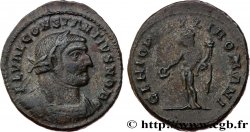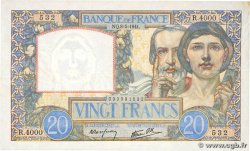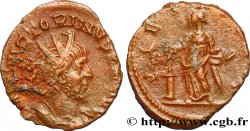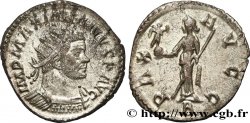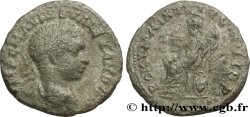v27_0324 - CONSTANTIUS I Follis ou nummus
MONNAIES 27 (2006)
Startpreis : 600.00 €
Schätzung : 900.00 €
Erzielter Preis : 600.00 €
Anzahl der Gebote : 1
Höchstgebot : 705.00 €
Startpreis : 600.00 €
Schätzung : 900.00 €
Erzielter Preis : 600.00 €
Anzahl der Gebote : 1
Höchstgebot : 705.00 €
Type : Follis ou nummus
Datum: 300-302
Datum: 300 - mi 304
Name der Münzstätte / Stadt : Lyon
Metall : Kupfer
Durchmesser : 30 mm
Stempelstellung : 6 h.
Gewicht : 11,03 g.
Seltenheitsgrad : R3
Officine: 2e
Emission: 8e
Kommentare zum Erhaltungszustand:
Exemplaire sur un flan extrêmement large et bien centré des deux côtés. Portrait exceptionnel avec une usure superficielle. Revers de style fin bien venu à la frappe. Jolie patine brun vert foncé marbrée superficiellement de rouge
N° im Nachschlagewerk :
Pedigree :
Cet exemplaire provient de la vente Gorny & Mosch 113, 18 octobre 2001, n° 6028
Vorderseite
Titulatur der Vorderseite CONSTANTIVS NOB CAES.
Beschreibung Vorderseite Buste lauré, drapé et cuirassé de Constance Ier césar à droite, vu de trois quarts en avant, tenant une haste de la main droite, reposant sur l’épaule droite et un bouclier de la main gauche (F*6).
Übersetzung der Vorderseite “Constantius Nobilissimus Cæsar”, (Constance très noble césar).
Rückseite
Titulatur der Rückseite GENIO POP-VLI ROMANI/ (AUTEL)|B// PLG.
Beschreibung Rückseite Genius (Génie) debout à gauche, coiffé du modius, le manteau sur l'épaule gauche, tenant une patère de la main droite et une corne d'abondance de la main gauche.
Übersetzung der Rückseite “Genio Populi Romani”, (Au Génie du Peuple romain).
Kommentare
Rubans convergents : rubans descendant verticalement le long de la nuque ou légèrement incurvés vers l’arrière (type 3). Le buste présente bien une haste reposant sur l’épaule et non pas un sceptre comme sur de nombreux exemplaires en particulier Bastien n° 213. Notre exemplaire est très proche de celui du Koninklijk Kabinet de La Haye n° 10.301, Bastien n° 213b, pl. XX. La cuirasse est ornée d’un motif qui n’est pas identifiable sur notre exemplaire. L’épaulière est figurée ainsi que les ptéryges tombant sur l’épaule. Le bouclier est vu de l’intérieur avec la main qui tient la lanière de l’arme de protection. Malgré la rareté de l’exemplaire, nous n’avons pas pu établir de liaison de coin pertinente. C’est le sixième exemplaire recensé avec cette césure. Prendra le numéro 213f dans le Supplément III.
Converging ribbons: ribbons descending vertically along the nape of the neck or slightly curved towards the back (type 3). The bust clearly shows a spear resting on the shoulder and not a scepter as on many examples, in particular Bastien no. 213. Our example is very close to that of the Koninklijk Kabinet of The Hague no. 10.301, Bastien no. 213b, pl. XX. The cuirass is decorated with a motif that is not identifiable on our example. The shoulder guard is depicted as well as the pteryges falling on the shoulder. The shield is seen from the inside with the hand holding the strap of the protective weapon. Despite the rarity of the example, we were unable to establish a relevant corner connection. This is the sixth example recorded with this caesura. Will take the number 213f in Supplement III
Converging ribbons: ribbons descending vertically along the nape of the neck or slightly curved towards the back (type 3). The bust clearly shows a spear resting on the shoulder and not a scepter as on many examples, in particular Bastien no. 213. Our example is very close to that of the Koninklijk Kabinet of The Hague no. 10.301, Bastien no. 213b, pl. XX. The cuirass is decorated with a motif that is not identifiable on our example. The shoulder guard is depicted as well as the pteryges falling on the shoulder. The shield is seen from the inside with the hand holding the strap of the protective weapon. Despite the rarity of the example, we were unable to establish a relevant corner connection. This is the sixth example recorded with this caesura. Will take the number 213f in Supplement III








 Berichten über einen Fehler
Berichten über einen Fehler Die Seite drucken
Die Seite drucken Teilen meiner Auswahl
Teilen meiner Auswahl Stellen Sie eine Frage
Stellen Sie eine Frage Einlieferung/Verkauf
Einlieferung/Verkauf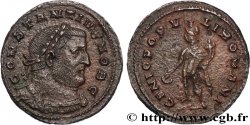
 Details
Details